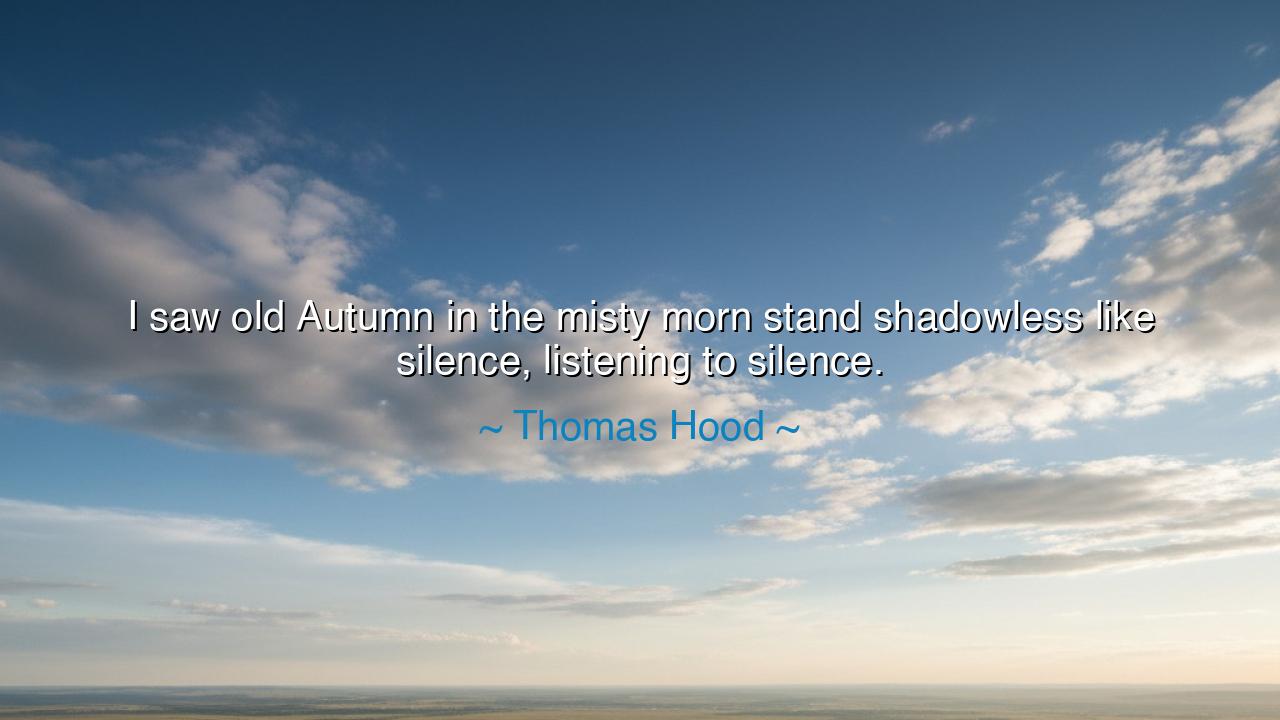
I saw old Autumn in the misty morn stand shadowless like
I saw old Autumn in the misty morn stand shadowless like silence, listening to silence.






Listen well, children of the ages, to the words of Thomas Hood, who, with heart attuned to the subtle cadences of the world, beheld the quiet majesty of Autumn and gave it voice: "I saw old Autumn in the misty morn stand shadowless like silence, listening to silence." Here, in this fleeting vision, we witness the season personified, a venerable elder who moves not with clamor, but with stillness, absorbing the whisper of the wind, the faint rustle of leaves, and the hidden music of the earth. Hood invites us into a realm where the external world and the inner soul converge, where silence speaks louder than words, and where time itself seems to pause in reverent attention.
In this vision, Autumn is neither hurried nor boastful. It stands shadowless, free of pretense, its presence subtle yet profound. The misty morn shrouds the world in gentle obscurity, softening edges and blending distinctions. In this, Hood reveals a deep truth: that wisdom and reflection often arise not in noise and action, but in the quiet observation of life. The season, with its fading light and falling leaves, mirrors the human journey of maturity, a reminder that all things pass and yet all things endure in their own rhythms.
Consider the historical example of the ancient philosophers who walked in groves and gardens, seeking insight in the quietude of nature. Socrates spoke of knowing oneself, yet he often did so under the dappled shade of trees, listening to the subtle shifts of air and birdcalls. Hood’s Autumn embodies this same principle: there is profound learning in listening, in being present to the subtle, the evanescent, the delicate truths that escape the clamor of hurried lives.
Notice too the language of contrast Hood employs: shadowless like silence. To be shadowless is to be unobtrusive, yet fully present; to be like silence is to be attentive, receptive, and open. In our human affairs, we too often act to impress, to assert, to fill the void with our voices. Yet, as Autumn demonstrates, there is strength in restraint, wisdom in stillness, and clarity in observing without immediate judgment. The world reveals its secrets not to the hurried or the loud, but to those who pause, who allow silence to become a teacher.
Let us bring this closer to our own experience. Have you ever walked through a foggy morning, hearing only the distant caw of a crow or the whisper of leaves underfoot? In those moments, the mind, freed from distraction, begins to see with clarity, to feel with depth, and to contemplate with a quiet joy. Hood’s vision is not merely poetic; it is an instruction: cultivate spaces of silence in your life, for it is there that truth, perspective, and peace can flourish.
We may also recall the great painters of Autumn, such as the Japanese masters of ukiyo-e, who captured the fleeting colors and mists with reverent precision. Their work teaches the same lesson: that attention, patience, and the gentle observation of change can yield beauty and understanding far beyond the reach of forceful action. Hood, like them, shows us that the world’s subtle transformations are worth witnessing, that the small and quiet carry eternal significance.
The lesson is thus twofold: first, honor the seasons of your own life, embracing change, decay, and renewal with awareness and gratitude. Second, cultivate attentive silence, for in it lies the power to see clearly, to understand deeply, and to act wisely. Like Autumn standing in mist, let yourself be present, absorbing, listening, and reflecting, rather than striving to dominate or overwhelm.
Practical action follows naturally: rise early to meet the world in quiet, walk through your surroundings with attentive senses, pause before speaking or acting, and let the soft rhythms of life guide your thoughts and decisions. Keep a journal of fleeting impressions, of the silent wonders you encounter, so that your life becomes enriched not by noise, but by presence, reflection, and the eternal music of listening to silence.
If you wish, I can also craft a narrative audio-ready version, where the rhythm of the words mirrors the misty, slow unfolding of Autumn, enhancing the meditative, evocative effect of Hood’s imagery. Do you want me to do that?






AAdministratorAdministrator
Welcome, honored guests. Please leave a comment, we will respond soon